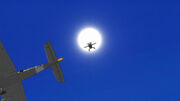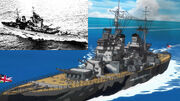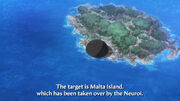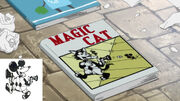The Island of Malta faces a Neuroi threat different than the ones previously faced by the Witches, and the circumstances surrounding that mean that only 2 witches can fight it at a time. One of those Witches turns out to be the Star of Africa, Hanna-Justina Marseille, visiting from Africa. She tries to reignite a rivalry with Trude and Erica, and succeeds to varying degrees, but is frustrated when none of the other witches take her claim to be the best with any particular interest.
Originally intended to work with Trude, Marseille claims that Trude isn't worthy of being her partner, and demands to work with Erica. She eventually calms down a bit after Erica agrees to partner with her, mostly for the sake of stopping any further arguments. Trude later humiliates herself trying to get an autograph for her younger sister, Chris, and Erica gets mad at Marseille for insulting her. The two make a deal, with Marseille agreeing to hand over an autograph if Erica can shoot down more Neuroi than her, as the Neuroi they have to face is full of multiple smaller targets.
Marseille and Erica defeat the Neuroi with ease, tying in their respective victories. Unsatisfied, they begin to duel with live rounds, with the loser being whoever uses their shield first. They tie, with both witches running out of ammunition. The episode ends with Tina tacitly admitting defeat by providing Chris with an autograph, presenting it to Minna as she prepares to fly back to Africa.
The Title "500 Overs" comes from the fact that the potential teams to take on the Neuroi over Malta, involving various combinations of Hanna, Trude, and Erica, would each have a combined total of over 500 victories. (In the Strike Witches world, Hanna-Justina has significantlly more victories by 1945 than her archetype had in total, due to his untimely death in 1942).
| << 09: "The Bridge to Tomorrow" | ^^ Strike Witches Season 2 Overview ^^ | 11: "To Be Myself" >> |
|---|
References
| Albert Kesselring -- Albert Kesselring (30 November 1885 – 16 July 1960) was a German Luftwaffe Generalfeldmarschall during World War II. In a military career that spanned both World Wars, Kesselring became one of Nazi Germany's most skilful commanders, being one of 27 soldiers awarded the Knight's Cross of the Iron Cross with Oak Leaves, Swords and Diamonds. Nicknamed "Smiling Albert" by the Allies and "Uncle Albert" by his troops, he was one of the most popular generals of World War II with the rank and file. Bernard Law Montgomery -- Field Marshal Bernard Law Montgomery, 1st Viscount Montgomery of Alamein, KG, GCB, DSO, PC (17 November 1887 – 24 March 1976), often referred to as "Monty", was a British Army officer. He saw action in World War I, and during World War II he successfully commanded Allied forces at the Battle of El Alamein, a major turning point in the Western Desert Campaign. He was later a prominent commander in Italy and North-West Europe, where he was in command of all Allied ground forces during Operation Overlord until after the Battle of Normandy, and was the principal commander for Operation Market Garden. After the War he became Commander-in-Chief of the British Forces of Occupation in Germany and then Chief of the Imperial General Staff. |
 Albert Kesselring and Bernard Montgomery |
| Marseille's Jump -- Hanna-Justina Marseille's jump from the Ju-52 is perhaps a rather morbid reference to how the real Marseille died. On 30 September 1942, Hauptmann Marseille was leading his Staffel on a Stuka escort mission, during which no contact with enemy fighters was made. While returning to base, his new Bf 109G-2/trop's cockpit began to fill with smoke; blinded and half asphyxiated, he was guided back to German lines by his wingmen, Jost Schlang and Lt Rainer Pöttgen. Upon reaching friendly lines, "Yellow 14" had lost power and was drifting lower and lower. Pöttgen called out after about 10 minutes that they had reached the White Mosque of Sidi Abdel Rahman, and were thus within friendly lines. At this point, Marseille deemed his aircraft no longer flyable and decided to bail out, his last words to his comrades being "I've got to get out now, I can't stand it any longer." His Staffel, which had been flying a tight formation around him, peeled away to give him the necessary room to manoeuvre. Marseille rolled his aircraft onto its back, the standard procedure for bail out, but due to the smoke and slight disorientation, he failed to notice that the aircraft had entered a steep dive (at an angle of 70-80 degrees) and was now travelling at a considerably faster speed (about 400 mph). He worked his way out of the cockpit and into the rushing air only to be carried backwards by the slipstream, the left side of his chest striking the vertical stabiliser of his fighter, either killing him instantly or rendering him unconscious to the point that he could not deploy his parachute. He fell almost vertically, hitting the desert floor seven km south of Sidi Abdel Rahman. Whilst checking the body, Oberarzt Dr Bick, the regimental doctor for the 115th Panzergrenadier-Regiment, noted Marseille's wristwatch had stopped at exactly 11:42 am. Dr. Bick had been the first to reach the crash site, having been stationed just to the rear of the forward mine defences. He had also witnessed Marseille's fatal fall.
While the jump may indeed be a reference to the real Marseille's death, the loss of Hanna's familiar is far more directly taken from that event. |
 Marseille's jump |
| Marseille's background -- Marseille's appearance and background, like other witches, are based on her archetype. Eduard Neumann(Hans' superior), said that "his hair was too long" while Steinhoff stated that "Marseille was extremely handsome. He was a very gifted pilot, but he was unreliable. He had girl friends everywhere, and they kept him so busy that he was sometimes so worn out that he had to be grounded. His sometime irresponsible way of conducting his duties was the main reason I fired him. But he had irresistible charm". In the anime Marseille had very long hair and 'fans all over the world, not just in Karlsland'. The part about her attitude need not much explanation. |  Marseilles |
| MG 34 -- The Maschinengewehr 34, or MG 34, was a German machine gun that was first produced and accepted into service in 1934, and first issued to units in 1935. It was an air-cooled machine gun firing the 7.92x57mm Mauser cartridge. However, it was also designed to perform both as a light machine gun and in heavier roles, as an early example of a general purpose machine gun. In the light-machine gun role, it was intended to be equipped with a bipod and 50-round ammunition belt contained in a drum-shaped magazine attached to the receiver. In the heavier role, it was mounted on a larger tripod and was belt-fed. In practice, the infantry relied mainly on belt-cartridge ammunition for the bipod version, functioning as a classic medium support infantry weapon. |  MG 34 |
| Winning the Race and Drinking Milk -- Marseille always strove to improve his abilities. He worked to strengthen his legs and abdominal muscles, to help him tolerate the extreme G-forces of air combat. Marseille also drank an abnormal amount of milk and shunned sunglasses, to improve his eyesight. |  Legs n' Milk |
| HMS King George V -- The second HMS King George V (pennant number 41) was the lead ship of the five British King George V-class battleships of the Royal Navy (RN). Laid down in 1937 and commissioned in 1940, King George V operated during World War II as part of the British Home Fleet and the British Pacific Fleet, along with transporting Winston Churchill to the Tehran Conference. Following the end of the war, King George V spent three years as flagship of the British Home Fleet, before she was placed into reserve in 1949. The battleship was scrapped in Dalmuir 8 years later. Following the tradition of naming the first battleship constructed in the reign of a new monarch after the current monarch, she was planned to be named King George VI (after George VI). However the King instructed the Admiralty to name the ship in honour of his father, George V. King George V was built by Vickers-Armstrong at Walker's Naval Yard, Newcastle upon Tyne and laid down on 1 January 1937, launched on 21 February 1939, and commissioned on 11 December 1940. |  HMS King George V |
| Akizuki class destroyer -- The Akizuki class destroyers (秋月型駆逐艦, Akizuki-gata kuchikukan) was one of the primary classes of new destroyers of the Imperial Japanese Navy (IJN) after 1942. The IJN called them Destroyer Type-B (乙型駆逐艦, Otsu-gata Kuchikukan) from their plan name. They were designed to fight larger ships, aircraft and submarines. This is considered to have been the most useful class of destroyers Japan fielded during the war and was well regarded in the IJN. They mounted a superb 3.9" (100mm) dual-purpose gun in four twin mounts. They also wereamong the first Japanese vessels equipped with radar. The ships were lighter in their torpedo armament, compared to contemporary destroyers (a single mount of four tubes, plus reloads), but the ships compensated with stronger anti-aircraft armament. |  Akizuki class destroyer |
| The Bismarck -- The German battleship Bismarck was one of the most famous warships of the Second World War. The lead ship of her class, named after the 19th century German Chancellor Otto von Bismarck, Bismarck displaced more than 50,000 tonnes fully loaded and was the largest warship then commissioned. Bismarck took part in only one operation during her brief career. She and the heavy cruiser Prinz Eugen left Gotenhafen (Gdynia) on the morning of 19 May 1941 for Operation Rheinübung, during which she was to have attempted to intercept and destroyconvoys in transit between North America and Great Britain. When Bismarck and Prinz Eugen attempted to break out into the Atlantic, the two ships were discovered by the Royal Navy and brought to battle in the Denmark Strait. During the short engagement, the British battlecruiser HMS Hood, flagship of the Home Fleet and pride of the Royal Navy, was sunk after several minutes of firing. In response, British Prime Minister Winston Churchill issued the order to "Sink the Bismarck," spurring a relentless pursuit by the Royal Navy. Two days later, with Bismarck almost in reach of safer waters, Fleet Air Arm Swordfish biplanes launched from the carrier HMS Ark Royal torpedoed the ship and jammed her rudder, allowing heavy British units to catch up with her. In the ensuing battle on the morning of 27 May 1941, Bismarck was heavily attacked for almost two hours before sinking. |  The Bismarck |
| I-400 class submarine -- The Sen Toku I-400-class (伊四〇〇型潜水艦) Imperial Japanese Navy submarines were the largest submarines of World War II and remained the largest ever built until the construction of nuclear ballistic missile submarines in the 1960s. They were submarine aircraft carriers able to carry three Aichi M6A Seiran aircraft underwater to their destinations. They were designed to surface, launch the planes then dive again quickly before they were discovered. They also carried torpedoes for close-range combat. The I-400-class was designed with the range to travel anywhere in the world and return. A fleet of 18 boats was planned in 1942, and work started on the first in January 1943 at the Kure, Hiroshima arsenal. Within a year the plan was scaled back to five, of which only three (I-400 at Kure, and I-401 and I-402 at Sasebo) were completed. |  I-400 class submarine |
| Malta -- The Siege of Malta was a military campaign in the Mediterranean Theatre of World War II. From 1940 to 1942, the fight for the control of the strategically important island of Malta pitted the air forces and navies of Fascist Italy and Nazi Germany against the Royal Air Force and the Royal Navy. In February 1941, the Deutsches Afrikakorps (German Africa Corps, or DAK) commanded by Generalfeldmarschall (Field Marshal) Erwin Rommel was sent to North Africa to prevent an Axis rout. Malta became a strategic and logistically vital base which could influence the outcome of the North African Campaign. From Malta, British air and sea forces could attack Axis ships transporting vital supplies and reinforcements from Europe. Rommel recognised its importance quickly. In May 1941, he warned that "Without Malta the Axis will end by losing control of North Africa." The Axis resolved to bomb or starve Malta into submission by attacking its ports, towns, cities and Allied shipping supplying the island. Malta was one of the most intensively bombed areas during the war. The Luftwaffe (German Air Force) and the Italian Regia Aeronautica (Italian Royal Air Force) flew a total of 3,000 bombing raids over a period of two years in an effort to destroy RAF defences and the islands' ports. In the end, Allied convoys were able to supply and reinforce Malta, while the RAF defended its airspace, though at great cost in material and lives. By November 1942, the Axis had lost the Second Battle of El Alamein and the United States of America landed United States Army forces in Vichy French Morocco and Algeria under Operation Torch. The Axis diverted their forces to the Battle of Tunisia, and attacks on Malta were rapidly reduced. The siege effectively ended in November 1942. In December 1942, air and sea forces operating from Malta went over the offensive. By May 1943, they had sunk 230 Axis ships in 164 days, the highest Allied sinking rate of the war. The Allied victory played a major role in the eventual Allied success in North Africa. |  Malta |
| Chandelle -- The chandelle (which is the French word for candle) is a precision aircraft control maneuver, and not strictly speaking an aerobatic, dogfighting, or aerial combat maneuver. It is rather a maneuver designed to show the pilot's proficiency in controlling the aircraft while performing a minimum radius climbing turn at a constant rate of turn (expressed usually in degrees per second) through a 180 degree change of heading, arriving at the new reciprocal heading at an airspeed in the "slow-flight" regime, very near the aerodynamic stall. The aircraft can be flown in "slow-flight" after establishing the new heading, or normal cruise flight may be resumed, depending upon the purposes of the exercise or examination. Barrel Roll -- A barrel roll is an aerial maneuver in which an airplane makes a complete rotation on its longitudinal axis while following a helical path, approximately maintaining its original direction. It is sometimes described as "a combination of a loop and a roll".The G-force is kept positive (but not constant) on the object throughout the maneuver, commonly not more than 2-3 G, and no less than 0.5 G. The one performed by Marseille is the High G Barrel Roll. |
 Do a barrel roll! |
| Adolf Galland's Nose Art -- Seen among the piles of junk in Erica's side of the room, the cover of this book is a reference to Adolf Galland's nose art. Luftwaffe aircraft did not often display nose art, but there were exceptions. For example, Mickey Mouse adorned a Condor Legion Bf-109 during the Spanish Civil War and one Ju-87A was decorated with a large pig inside a white circle during the same period. Adolf Galland's Bf-109E-3 of JG 26 also had a depiction of Mickey Mouse, holding a contemporary telephone in his hands, in mid-1941. |  Mickey Mouse? More like Magic Cat. |
| << 09: "The Bridge to Tomorrow" | ^^ Strike Witches Season 2 Overview ^^ | 11: "To Be Myself" >> |
|---|